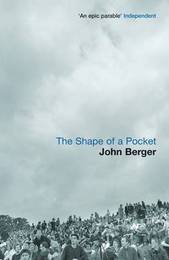
|
The Shape of a Pocket
Paperback / softback
Main Details
| Title |
The Shape of a Pocket
|
| Authors and Contributors |
By (author) John Berger
|
| Physical Properties |
| Format:Paperback / softback | | Pages:272 | | Dimensions(mm): Height 198,Width 129 |
|
| Category/Genre | Literary essays
Economic systems and structures |
|---|
| ISBN/Barcode |
9780747558101
|
| Classifications | Dewey:330.122 |
|---|
| Audience | | Tertiary Education (US: College) | |
|---|
| Edition |
New edition
|
| Illustrations |
illustrations
|
|
Publishing Details |
| Publisher |
Bloomsbury Publishing PLC
|
| Imprint |
Bloomsbury Publishing PLC
|
| Publication Date |
19 August 2002 |
| Publication Country |
United Kingdom
|
Description
'The pocket in question is a small pocket of resistance. A pocket is formed when two or more people come together in agreement. The resistance is against the inhumanity of the new world economic order. The people coming together are the reader, me and those the essays are about - Rembrandt, Palaeolithic cave painters, a Romanian peasant, ancient Egyptians, an expert in the loneliness of certain hotel bedrooms, dogs at dusk, a man in a radio station. And unexpectedly, our exchanges strengthen each of us in our conviction that what is happening to the world today is wrong, and that what is often said about it is a lie. I've never written a book with a greater sense of urgency.' John Berger
Author Biography
John Berger was born in London in 1926. His many books include the Booker Prize winning novel G and, more recently, TO THE WEDDING. Amongst his outstanding studies of art and photography are ANOTHER WAY OF TELLING, THE SUCCESS AND FAILURE OF PICASSO and the internationally acclaimed WAYS OF SEEING. He lives and works in a small village in the French Alps, the setting for his trilogy INTO THEIR LABOURS. His latest novel KING was published in 1998.
Reviews"John Berger writes: 'The pocket in question is a small pocket of resistance. A pocket is formed when two or more people come together in agreement. The resistance is against the inhumanity of the new world economic order. The people coming together are the reader, me and those the essays are about - Rembrandt, Palaeolithic cave painters, a Romanian peasant, ancient Egyptians, an expert in the loneliness of certain hotel bedrooms, dogs at dusk, a man in a radio station. And unexpectedly, our exchanges strengthen each of us in our conviction that what is happening to the world today is wrong, and that what is often said about it is a lie. I've never written a book with a greater sense of urgency.'
|